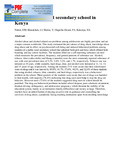| dc.description.abstract | Alcohol abuse and alcohol-related use problems among adolescents are highly prevalent and are a major concern worldwide. This study estimated the prevalence of drug abuse, knowledge about drug abuse and its effect on psychosocial well-being and induced behavioral problems among students of a public rural secondary school that admitted both girls and boys which offered both boarding and day school facilities. The students filled out a self-reporting substance use tool which measures the prevalence, frequency, and general patterns of substance use. Alcohol, tobacco, khat (catha edulis) and bhang (cannabis) were the most commonly reported substance of use, with user prevalence rates of 5.2%, 3.8%, 3.2%, and 1.7%, respectively. Tobacco use was initiated at 10 years, while cannabis, hard drugs, khat, and alcohol were initiated at 11, 12, 13, and 15 years of age, respectively. Among the students 71% were aware that their schoolmates were on drugs and it was known by 49.8%, 41.7%, 37.6%, 44.3%, and 32.4% of these students that using alcohol, tobacco, khat, cannabis, and hard drugs, respectively was a behavioral problem in the school. Three quarters of the students were aware that use of drugs was harmful to their health, with majority (78.6%) indicating that drug users need help to stop the drug use behavior. However most (73.6%) of the students suggested drug users in school should be punished. The drug use behavioral problems included school dropout, poor scholastic attainment, drunken driving, delinquency, and adolescence pregnancy which threaten the stability of the education system, family as an institution (family difficulties) and society at large. Therefore, teachers have an added burden of playing an active role in guidance and counselling the survivors of drug abuse, a pandemic facing teaching institutions apart from instilling knowledge | en |

